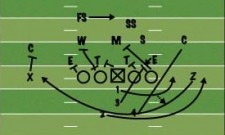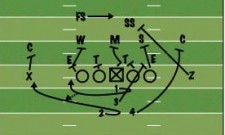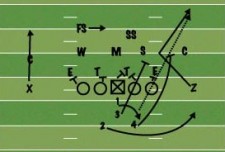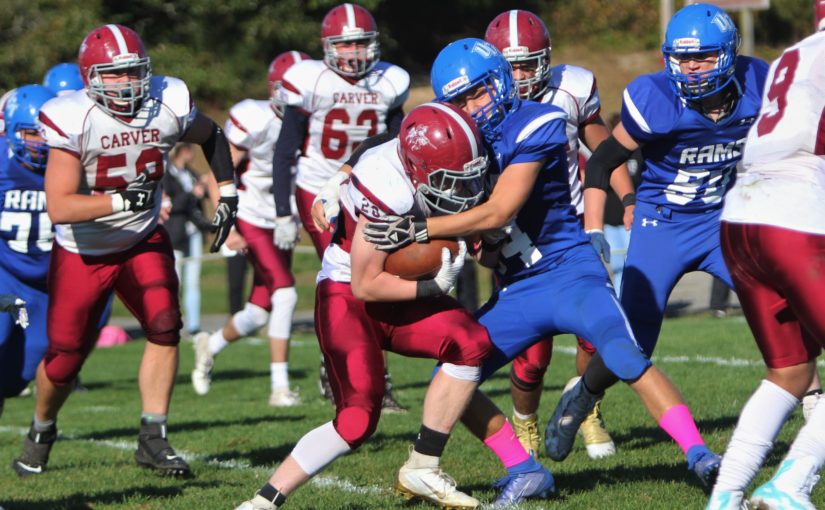Football: Complementary plays to the wishbone triple option
The wishbone triple option play is the base play within the greater wishbone-triple-option offensive philosophy. As its name indicates, it’s actually three plays in one. There is a dive option to the fullback; a quarterback-keeper, off-tackle option; and a half-back option pitch play to the perimeter of the field.
Many triple-option teams prefer to use this option play repeatedly. At some point during a game, however, it does become necessary to change it up to keep the defense guessing. It’s at this point in a game when triple-option complementary plays should be put into the game plan.
Wishbone option, triple right
This play is the base play of the wishbone triple-option series of plays. DIAGRAM 1: Wishbone option, triple right. The quarterback (1) is lined up directly behind the center. The fullback (3) places his down hand exactly two yards behind the QBs feet. The two halfbacks (2 and 4) are split behind the FB with their feet two yards behind the FBs feet, and their bodies aligned directly behind the offensive guards.
DIAGRAM 1: Wishbone option, triple right. The quarterback (1) is lined up directly behind the center. The fullback (3) places his down hand exactly two yards behind the QBs feet. The two halfbacks (2 and 4) are split behind the FB with their feet two yards behind the FBs feet, and their bodies aligned directly behind the offensive guards.
At the snap, the QB places the ball into the mid-section of the FB whose aiming point is the backside of the offensive guard. During this mesh, the QB reads the first defensive down lineman in the B-gap to the outside (called the Dive Key). In this instance, it is the defensive end.
The QB gives the ball to the FB every time unless the dive-key player comes down hard and flat on the FB. If that dive-key player does come down both hard and flat on the FB, the QB is to disengage from the mesh and immediately attack the pitch-key player (the next defensive player out from the dive key).
In this instance, the pitch key is the cornerback. The QBs thinking is I will run for a touchdown every time unless the pitch-key player turns his outside shoulder toward me. If the pitch key does turn his outside shoulder toward the QB, the QB then looks and pitches the ball to the trailing pitchman. At some point in the game, the defense undoubtedly adjusts to the triple options intricacies and make some changes. It is at this point that the offensive coordinator should implement some triple-option complementary plays to thwart the defenses attempts to stop the rushing onslaught.
Wishbone Open, F triple-right, Z-reverse
This play should be run exactly like the base triple play. The only differences are the blocking assignments and the role of the Z receiver.
 DIAGRAM 2: Wishbone open, F triple-right, Z-reverse. It’s imperative that this play be run to look exactly like the base triple play. The beauty of this strategic tactic is to show the defense nothing different as this play gets underway. This helps avoid any proverbial tip off, which could lend the defense a decided advantage.
DIAGRAM 2: Wishbone open, F triple-right, Z-reverse. It’s imperative that this play be run to look exactly like the base triple play. The beauty of this strategic tactic is to show the defense nothing different as this play gets underway. This helps avoid any proverbial tip off, which could lend the defense a decided advantage.
The play begins with a quick QB-FB mesh (in other words, no long mesh ride) followed by the QB taking the ball parallel along the line of scrimmage (LOS) toward his supposed pitch-key players. Both the dive and pitch keys are blocked on this play and, therefore, the QB does not have to read either of these defenders.
The key to this play is the athletic ability of the Z receiver who, upon the snap, runs a tracked path between the lead back (4) and the pitch man (2). The QB pitches the ball to the Z receiver, who then takes the ball to the periphery, follows his blockers to the seam and runs downfield. This play is devastating once the offensive team has lulled the defense to sleep by repeatedly running the base triple-option play.
The counter action on this play leaves the defense flabbergasted, as the defenders often cheat to the play side as the feigned triple-option play appears to be unfolding. This complementary play is designed for the second half of a game after the the triple option has been thoroughly established.
Wishbone open, double-counter option left
The double-counter option play feeds off of the success of the base triple-option play.
 DIAGRAM 3: Wishbone open, double-counter option left. The play begins with the QB reversing out and performing a quick mesh with the FB. The play appears to be heading toward the right side of the field (see Diagram 1) as the entire backfield personnel all take their lead steps in that direction.
DIAGRAM 3: Wishbone open, double-counter option left. The play begins with the QB reversing out and performing a quick mesh with the FB. The play appears to be heading toward the right side of the field (see Diagram 1) as the entire backfield personnel all take their lead steps in that direction.
After completing the fake handoff to the FB, the QB reverses his direction and heads toward the pitch key (the defensive end). It’s very important that the offensive left tackle scrapes the pitch key before he continues on to his main blocking assignment, which is the Will linebacker. This scrape delays the attack of the DE on the QB.
After making his read, the QB either takes the ball off tackle or pitches the ball to the trailing HB.
Wishbone open, Z-slant corner
This play also takes advantage of the defenses preoccupation with trying to stop the base triple play.
 DIAGRAM 4: Wishbone open, Z-slant corner. The QB opens up and does a quick QB-FB mesh which should, in theory, keep the linebackers at bay since they are reading a triple-option run play once again. The two HBs run their assignments as if it’s the base triple play.
DIAGRAM 4: Wishbone open, Z-slant corner. The QB opens up and does a quick QB-FB mesh which should, in theory, keep the linebackers at bay since they are reading a triple-option run play once again. The two HBs run their assignments as if it’s the base triple play.
The Z receiver also appears to be headed toward the strong safety to perform his block during the base triple option. Once the Z receiver runs his slant pattern towards the SS, he immediately changes direction and runs a corner route. The beauty of this play is that whether or not the SS decides to follow the Z receiver, the worst-case scenario for is a one-on-one coverage situation on your best receiver down the field.
Just remind all five linemen to stay within a yard of the LOS or else this play will be called back due to an illegal-man-downfield penalty.





